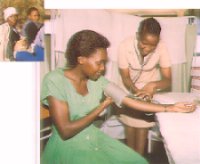


Botswana's primary health care strategy continues to make remarkable strides in extending health services, particularly to the rural population, through a network of primary hospitals, clinics and mobile services. Numerous positive aspects are ensuring that Botswana is well on its way to the goal of health care being available to all by the year 2000.
A blood pressure check being carried out at the Gabane Clinic. ->
At the present time, close to 90 percent of Botswana's population is within easy reach of a health care facility.
HEALTH PERSONNEL
Each health region is headed by a district medical officer. In a country which has no serious problems in the field of nutrition, the ratio of doctors to members of the population is probably the best in sub-Saharan Africa. In 1991 there were, as ratios per 10 000 population, fewer than two doctors, over 20 nurses and five family welfare educators.
HEALTH FACILITIES
Primary health care (integrated, preventative, curative and promotive)
is available at health posts, clinics and primary hospitals. The
health post is the smallest unit and serves an area containing
less than 500 people while clinics, likewise an outpatient facility,
serve 500 to 10 000 people. Primary hospitals, with a bed capacity
numbering from 30 to 70, play a dual role in that they not only
serve as agents of primary health care but also perform a range
of activities which include out-patient and general in-patient
care. Finally, there are the district hospitals as well as two
referral hospitals. Several main centres boast hospitals built
by mining companies; at Selebi-Phikwe the hospital was built by
the government while the mine runs its own hospital.
The number of clinics in the more remote parts of the country
has increased.

Over the period 1986 - 1991 the number of clinics increased from 150 to 180 and the number of health posts from 277 to 308. In 1988 the government extended its coverage of the more remote parts of the country, with the biggest increase in this period being seen in the number of mobile stops made. The availability of beds at hospitals and clinics also increased, while total attendance was higher due to easier access to health facilities. An increasing number of people are joining the family planning programme each year.
RESEARCH AND CONTROL
The notifiable diseases surveillance system was developed to effectively monitor and control the outbreak and spread of certain diseases of a potentially epidemic nature. The four most significant diseases are malaria, measles, viral hepatitis and diarrhoea with AIDS the subject of a separate programme managed by the National AIDS Control Programmes Division - control of sexually transmitted diseases remains one of the more effective strategies available for trying to contain the AIDS epidemic.
PRIVATE HOSPITALISATION
Providing a measure by which future ventures may be judged is the private hospital at Gaborone, an ambitious project which took five years to bring to fruition. Owned entirely by local resident investors and the Botswana development Corporation, the hospital is managed by a specialist division of the PARC group of Companies which has to its credit many years of experience in managing hospitals internationally. The first of its kind in Botswana, this has been one of the largest and most exciting developments in the field of health care in the country. The hospital provides world-class medical facilities and a high level of treatment and service for its customers, utilising international specialists, full-time consultant doctors, highly trained and experienced nurses, with a fully computerised administration system. The most sophisticated, state-of-the-art medical equipment has been sourced from a wide range of countries, including the United States, Holland, Germany and Japan.

 go back
go back